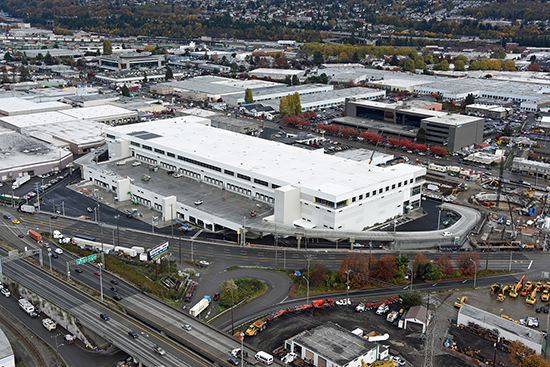|
Subscribe / Renew |
|
|
Contact Us |
|
| ► Subscribe to our Free Weekly Newsletter | |
| home | Welcome, sign in or click here to subscribe. | login |
Construction
| |
 |
September 27, 2019
Low-rise structures (tilt up)

Georgetown Crossroads
Location: Seattle
Owner/developer: Prologis
Team: Sierra Construction, general and concrete contractor; Nelson, architect; DCI Engineers, structural engineer; Stoneway Concrete, ready-mix supplier
Georgetown Crossroads, a multilevel industrial facility, is the first of its kind in the United States.
What was a former shipping container storage site south of downtown Seattle is now a modern warehouse in a land-constrained urban area that gives commercial tenants a competitive edge for shortening delivery times to the end customer.
The three-level warehouse, at 589,000 square feet, offers more than double the capacity of what would have been possible for a one-story building. The truck courts and docks provide distribution center-type functionality. The floor layout is sized for material distribution via forklifts. The warehouse stands at about the height of a nine-story building and includes two levels of 130-foot semi-truck loading courts.
Level 1 can receive delivery trucks from both sides of the building (42 dock doors on the east side of the building and 24 dock doors on the west side); Level 2 includes two ramps designed for additional full-size trailer access (37 dock doors on the west side of the building). Level 3 is designed for light manufacturing or production space.
The structural engineer of record designed and detailed the warehouse’s floor framing, roof framing, column and wall framing, lateral force resisting system, truck court framing and the structural transition to the bridge ramps.
An estimated 27,000 cubic yards of concrete was supplied for the project. The engineering team achieved the 50-by-45-foot and 60-foot speed bay column spacing and tall floor-to-floor heights (32 feet at Level 1). To accommodate the structural loads, the structural engineer designed member sizes comparable to those found in a tower structure. Built-up steel girders and custom beam-to-beam connections provided economy for the large bay dimensions and warehouse loading criteria.
The building's construction category is Type IB, which guided the project designers to build the facility with exterior tilt-up concrete panels. At 7.75 inches thick, the panels achieve a three-hour fire rating and reduced the cost of cladding compared with that of metal framing. They also provide a robust finish for the dock doors and distribution activity of the lower two levels.
To maximize the bays of dock doors, the structural engineer used the perimeter tilt panels in lieu of steel braced frames for the lateral force resisting system. The tilt panels could not extend practically to the 85-foot tall roof, so the engineering team developed an additional seismic load transfer from the braced frames above to the lower-level tilt panels.
Another design challenge was the floor truck court, which has a 4-foot elevation difference from the interior space. To achieve the elevation difference, the engineers worked with the general contractor to design specific connections through the steel framing and tilt panels that accommodated the construction sequencing at this complex area of the project.
The project team's effort for these connections enabled full seismic load transfer through the elevation step and avoided a costly seismic joint and extra shear walls or braced frames, which would have reduced the number of dock doors for the truck court.
Other Stories:
- GRAND AWARD
Infrastructure (transportation) - Low-rise structures
- Mid-rise structures (nonresidential)
- High-rise structures
- Infrastructure (non-transportation)
- Concrete paving
- Architectural and artistic
- Sustainable and resilient


